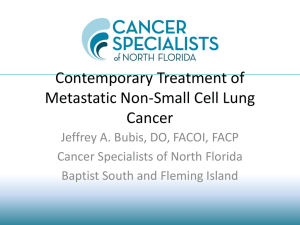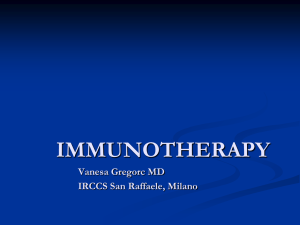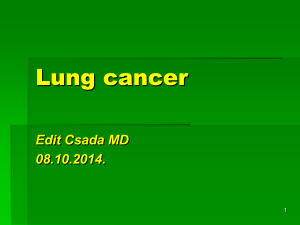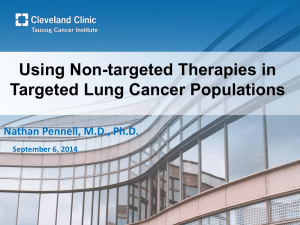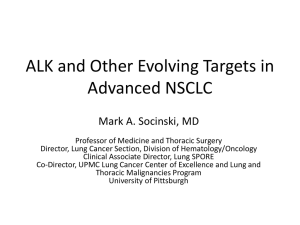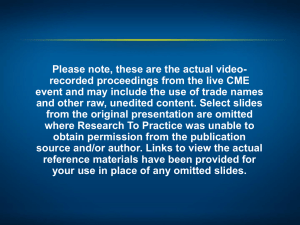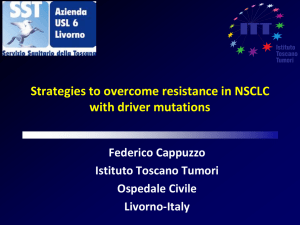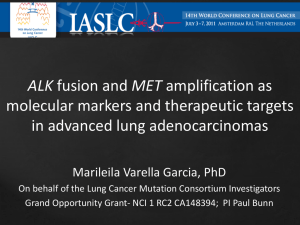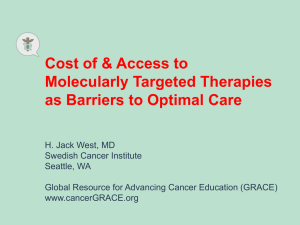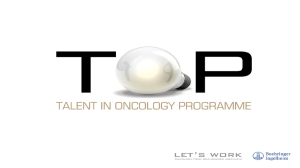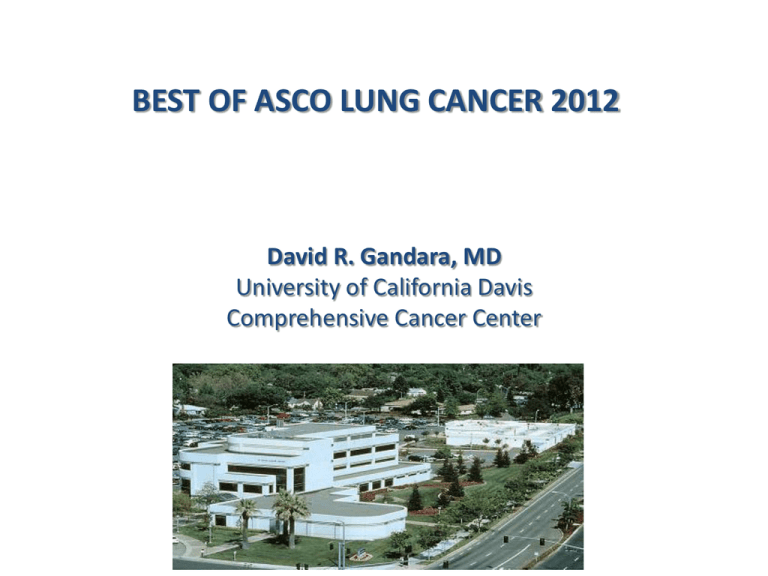
BEST OF ASCO LUNG CANCER 2012
David R. Gandara, MD
University of California Davis
Comprehensive Cancer Center
Disclosures
• Research Grants: Abbott, BMS/ImClone,
Genentech, GSK, Lilly, Merck, Novartis
• Consultant: Abbott Molecular, AstraZeneca,
Biodesix, Boehringer-Ingelheim, BMS/ImClone,
Caris, Celgene, GlaxoSmithKline, Genentech,
Lilly, Merck, Novartis, Pfizer, Response Genetics,
Sanofi-Aventis
BEST OF ASCO LUNG CANCER 2012
Abstracts for Discussion:
– Small Cell Lung Cancer (SCLC):
• Limited & Extensive Stage
– Non Small Cell Lung Cancer(NSCLC):
• Genomics: The “Big Bang” effect
• Advanced Stage NSCLC
– Targeted Therapies: “Coming of Age”
» ALK
» ROS1
» MEK
– Emerging Role of Immunotherapy
SCLC Abstracts for Discussion
• #7004: Concurrent TRT-Chemotherapy: 1st Cycle vs 3rd Cycle.
Phase III (Park et al)
• #7003: Amrubicin-Cisplatin vs Irinotecan-Cisplatin in E-SCLC.
Phase III JCOG 0509 (Kotani et al)
• #7005: Weekly Topotecan +/- AVE0005 (Aflibercept) in 2nd line
therapy of E-SCLC. Randomized Phase II S0802 (Allen et al)
#7004
Limited Stage:
Timing of
Chemo-Radiation
#7003
Extensive Stage
1st Line Chemotherapy:
Amrubicin
#7005
Extensive Stage
2nd Line Therapy:
AVE0005
Demographic, Biologic, Clinical & Therapeutic
Differences between SCLC & NSCLC
Feature
SCLC
NSCLC
Incidence
Decreasing
Increasing
Association with Smoking
Universal
Highly Variable
Growth Kinetics
~Rapid
Variable
Biologic Diversity
(Histologic & Molecular)
~Homogeneous
Distinct Subtypes
Early Metastases
Universal
Variable
Sensitivity to DNA-damaging
chemotherapy (1st line)
High
Variable
Sensitivity to Radiotherapy
High
Variable
Advances in Therapy ~15 years
Few Advances
Dramatic Advances
#7004: 1st versus 3rd Cycle TRT + Cisplatin-Etoposide
in L-SCLC (Park et al)
1st Cycle
arm
E
P
(n=111)
LD-SCLC
Treatmentnaïve
E
P
E
P
E
P
TRT
EP: Etoposide 100mg/m2 D1-3
R
1:1
PCI for patients
with PR or CR
Cisplatin 70mg/m2 D1, q3 w
TRT: 52.5 Gy/25 fxs (2.1 Gy/fx, once daily)
N=219
3rd Cycle
Delayed
arm
E
P
E
P
(n=108)
E
P
E
P
TRT
Primary end point: Complete response rate (WHO criteria)
Secondary end point: ORR, OS, PFS, and toxicity (NCI-CTC ver. 2.0)
Enrollment between 2003 and 2010 (7 years)
Median Follow Up is 59.4 months (about 5 years)
Efficacy Comparisons:
1st (initial) vs 3rd (delayed) cycle TRT
Favors Cycle 1 but not significantly different
Perspective on this Abstract:
Therapy of Limited Stage SCLC
• Platinum/Etoposide (PE) + 1st cycle concurrent thoracic
radiotherapy (TRT) has been standard of care in the U.S. for
~20 years
• Regimens adding new systemic agents or substituting agents
have generally failed to show sufficient promise to replace PE
• Advance: Twice day hyperfractionated RT + PE was proven
superior to once daily standard fraction RT (Turrisi et al:
NEJM, 1999), but has not been widely adopted in practice
• A great deal of attention has already been paid to optimizing
the timing of TRT in L-SCLC. Why Revisit It Now?
• In reality, 1st cycle concurrent TRT is not feasible in a substantial
subset of patients with L-SCLC
• Radiation volume considerations (V20 or other parameters)
• Delays in radiation planning in some settings/countries
• Need for systemic therapy on an urgent basis in some cases
Meta-Analysis of TRT Timing: Overall Survival
2-3 Year OS
5 Year OS
Meta-Analysis
Favors Early TRT
Pijls-Johannasma et al:
Cancer Treat Rev, 2007
Two Ongoing Phase III Trials in L-SCLC:
Testing Radiation Dose Schedules
Amended to allow Cycle 1 or Cycle 2 TRT
Testing Cycle 2 TRT in both arms
• Both are focused on TRT Dose Schedule
• Neither is investigating timing of TRT
Summary: #7004 Timing of TRT
• The results add to literature concluding that early
TRT is important (but not necessarily cycle 1) in
optimizing efficacy of Chemo-Radiation in L-SCLC
• Cycle 1 TRT leads to an increase in some toxicities
• Other ongoing Phase III trials are investigating
alternative TRT dose schedules but not timing or
radiation volume issues
• New systemic agents for inclusion into chemoradiation regimens for L-SCLC are needed
#7003: JCOG 0509 (Kotani et al)
ED-SCLC
20-70 yrs
PS 0-1
IP
Stratification
● PS
● institution
● sex
Sample size
n= 282
(n= 141 per Arm)
R
A
N
D
O
M
I
Z
E
Irinotecan 60 mg/m2 D1,8,15
Cisplatin 60 mg/m2 D1
Q4 weeks x 4 cycles
PCI if CR
(2.5Gy/10 Fx)
Amrubicin* 40 mg/m2 D1-3
Cisplatin 60 mg/m2 D1
Q3 weeks x 4 cycles
AP
•
•
•
•
Primary Endpoint= OS
IP dose schedule was identical to J9511 & SWOG 0124
Amrubicin dose amended to 35 mg/m2 due to FN
Trial was closed early by the DSMC
Efficacy Comparisons: AP versus IP (JCOG0509)
Phase III Investigation of “Newer”
Chemotherapeutic Agents in E-SCLC
Response Rate in Phase II:
1st line/2nd line
Results (1st line in combination
with Platinum)
Paclitaxel
~35%/~25%
Negative Phase III trial
(Niell et al)
Gemcitabine
~25%/14%
Phase II: not promising
(Hesketh et al)
Topotecan
?/~18%
“Positive” Phase III:
but not adopted
(Heigener et al)
Irinotecan
~35%/~25%
Conflicting results of
Phase III trials
(Noda; Lara; Hanna)
?
Negative Phase III trial
(Socinski et al)
~40%
Negative Phase III trial as
2nd line- single agent
( Jotte et al)
Agent
Pemetrexed
Amrubicin
from Gandara et al: NCI Early Drug Development Symposium, April 2012
Comparative Efficacy of JCOG 9511 versus SWOG 0124
S0124 did not confirm results of J9511
Efficacy of Irinotecan greater in Japanese patients
Toxicity was also greater in Japanese patients
Population-related Pharmacogenomics may have influenced results
Lara et al: JCO, 2009
Summary: #7003: AP vs IP in 1st Line Therapy
of E-SCLC
• Another promising drug in SCLC has failed to pass
the Phase III test
• Approaches exploiting the initial high sensitivity of
SCLC to 1st line DNA-damaging chemotherapy are
worth pursuing (ECOG 2511: PARPi ABT888)
• Demonstrating new agent activity in the 2nd line
setting in platinum-refractory disease may be a
logical prerequisite for testing in the 1st line setting
#7005: Topotecan +/- AVE0005 (Aflibercept) in
2nd Line Therapy of E-SCLC (S0802- Allen et al)
Eligibility Criteria
Small cell lung cancer
Extensive or limited stage
1 prior platinum-based
chemotherapy regimen
ECOG PS 0-1
Adequate organ function
No “anti-angiogenic” risk
factors
S
T
R
A
T
I
F
Y
Platinum Sensitive
Response to 1st Line
Chemotherapy and
Progression > 90 days
(ES) or 180 days (LS)
Platinum Refractory
Progression ≤ 90 days
(ES) or < 180 days
(LS) after 1st Line
Chemotherapy
R
A
N
D
O
M
I
Z
E
R
A
N
D
O
M
I
Z
E
Topotecan IV
4 mg/m2 Days 1, 8, and 15
AVE0005 IV
6 mg/kg on Day 1
Topotecan IV
4 mg/m2 Days 1, 8, and 15
Topotecan IV
4 mg/m2 Days 1, 8, and 15
AVE0005 IV
6 mg/kg on Day 1
Topotecan IV
4 mg/m2 Days 1, 8, and 15
* Topotecan is omitted on Day 15 for all patients starting on Cycle 5.
#7005: Efficacy of Topotecan +/- AVE0005
Perspective on this Abstract:
2nd Line Therapy of Extensive SCLC
• In 2nd line therapy, a number of chemotherapeutic agents
are active in “platinum-sensitive” patients, but the
“platinum-refractory” subset fares poorly
• Example: Topotecan is primarily active only in “platinumsensitive” patients
• Identifying agents active in the “platinum-refractory” subset
is therefore a high priority in clinical research in SCLC
• Additional studies evaluating novel targeted agents in SCLC
are needed
Investigation of “Targeted Therapies” in Extensive SCLC
Selected Agents
Target(s)
Results
Imatinib
(Johnson et al)
KIT, SCF
Inactive
Bec2/BCG
(Giaccone)
GD3 ganglioside
Bortezomib (PS-341)
(Lara et al)
Proteasome
Sorafenib
(Gitliz et al)
VEGFR
Vandetanib (ZD6474)
(Arnold et al)
EGFR/VEGFR
ABT263 & Obatoclax
(Rudin et al; Langer et al)
Bcl-2
Negative Phase III trial
Insufficient activity
Insufficient activity
PR: PlatSens: 5% PlatRef: 2%
HR 1.43 vs Placebo for OS
Insufficient activity
PE + GDC0449
orofIMC-A12:
Hedgehog
or occur without
Pending
Completion
• Biologic
Activity
some Targeted
Agents may
RECIST
response
E1508
(Belani/Rudin)
• Manifest
as improved DCR IGF-1R
(CR/PR + SD), PFS/OS or Biomarker/Imaging effects
• “Four
Dimensional
Model”PARP
ABT888
+ PE
vs PE: E2511
Pending Activation
(Owonikoko/Belani)
Measuring Effects of “Novel Therapeutic Agents”:
A Four Dimensional Model
Classic Tumor Response
(RECIST)
Disease Control
(CR + PR + SD)
or Timed DCR
Survival Endpoints
(OS, PFS)
Biologic Effects on Tumor
(Biomarkers, Functional imaging)
adapted from Gandara et al,
Clin Lung Cancer, 2007
Biologic Activity without RECIST Response
Phase II Study of Aflibercept in Refractory NSCLC
Number of
patients
98
Treatment
Aflibercept 4 mg/kg
q 2 wks
Primary
Objective
(RECIST)
Best response vs baseline
69.4% pts ≥ 3 lines
ORR 2 %
95% CI [0.2 – 7.2%]
20
Best % Tumor Shrinkage
Prior treatment
40
0
-20
-40
Patients
Leighl et al: J Thorac Oncol , 2010
SHARP Trial: Sorafenib vs Placebo in Hepatocellular Cancer
Llovet et al: NEJM 2008
Summary: #7005: Topotecan +/-VE0005
• The S0802 trial met the primary endpoint of improved 3month PFS
• RECIST response was low & there was no impact on OS
• These data remain hypothesis-generating & require
confirmation (Predictive Biomarker development is essential)
• How to best combine VE0005 & Chemotherapy remains
unclear
Advances in Sequencing Technologies and Human Genomics
(kilobases/day/machine)
Sequencing Technology
Massively parallel sequencing
Capillary sequencing
Gel-based Systems
& Lung Cancer (year)
Automated
slab gel
(50)
Manual
slab gel
(10)
I
1975
I
Human Genomics
2nd generation
capillary
1st generation sequencer
(103)
capillary
sequencer
(102)
I
1980
I
I
1985
I
I
1990
I
I
1995
I
Ras mutations
as 1st oncogenes
(1982)
I
2000
I
Single
molecule?
(109)
Short-read
sequencers
(107)
Microwell
pyrosequencing
(105)
I
2005
I
EGFR mutations
(2004-2009)
Human Genome
Project
1000 Human
(2001-2006)
Genome
(2007- )
Somatic mutations in
lung adenocarcinoma
(2008)
Li, Gandara et al: JCO 2012 (in press)
I
2010
I
Future
ALK gene
rearrangement
(2007-2011)
The Cancer
Genome Atlas
(2010- )
lung adenocarcinoma
genome (2008)
Small cell lung cancer
genome (2009)
Squamous cell lung
cancer genome (2012)
Comprehensive
Characterization of
Squamous Cell
NSCLC (SCCA) #7006
Ramaswamy Govindan, Peter Hammerman, Neil Hayes, Matthew
Wilkerson, Steve Baylin and Matthew Meyerson
On Behalf of the Lung Cancer Working Group of
The Cancer Genome Atlas (TCGA) Project
#7006: Characterization of Genomic Alterations
in Cancer (TCGA)
Structural variants
•
•
•
Translocations
Fusions
Inversion
Copy number
alterations
•
•
•
Amplifications
Deletions
LOH
Point mutations &
indels
•
•
•
•
Missense
Nonsense
Splice site
Frameshift
Gene expression
•
•
•
Outlier expression
Isoform usage
Pathways & signatures
Wild type AGTGA
Mutant
AGAGA
• This presentation: Squamous Cell Cancer
• Goal
500
• Accrued so far
300
• Analysis completed
178 reported here
From Govindan et al: ASCO 20`2
#7006: NSCLC (including SCCA) has a
very high rate of somatic mutations
n=109 81
64
38
316
100 / Mb
10 / Mb
1 / Mb
100
17
82
28
119
20
“Smart Cancers”
“Stupid Cancers”
0.1 / Mb
?
?
29
40
CarcinogenInduced Cancers
Ovarian, Breast &
Prostate Cancers
Hematologic &
Childhood
Cancers
21
Courtesy: Gaddy Getz and Mike Lawrence,
Broad Institute, MIT
mRNA Expression Analysis of SCCA
15%
36%
PI3K
alterations
30
24%
25%
NF1 loss
New Therapeutic Targets in squamous
cell lung carcinoma (SCCA)
Gene
Event Type
Frequency
CDKN2A
Deletion/MutationMethylation
72%
PI3KCA
Mutation
16%
PTEN
Mutation/Deletion
15%
FGFR1
Amplification
15%
EGFR
Amplification
9%
PDGFRA
Amplification/Mutation
9%
CCND1
Amplification
8%
DDR2
Mutation
4%
BRAF
Mutation
4%
ERBB2
Amplification
4%
FGFR2
Mutation
3%
Summary: Characterization of Squamous Cell
NSCLC (SCCA)
• SCCA characterized by: Complex genomes with
frequent and unique rearrangements
• Proposed a molecular sub-classification (yet to be
clinically validated)
• Multiple mechanisms for alteration/inactivation of the
same gene (e.g. CDKN2A)
• Potentil therapeutic targets identified in 75% of patients,
including FGFRs, PI3 kinase pathway, EGFR/ERBB2
and Cyclin/CDK complexes
“Targeted Therapies Coming of Age”
(from Li, Gandara et al: JCO 2012, in press)
Adenocarcinoma
NSCLC
as one
disease
Squamous Cell Cancer
FGFR1
Amp
EGFRvIII
Unknown
Histology-based Subtyping
PI3KCA
EGFR
DDR2
#7500: LUX-Lung 3: Phase III trial of afatinib versus pemetrexed and
cisplatin as first-line treatment for EGFR mutation+ adenocarcinoma
(Yang et al)
Stage IIIB-IV
Adenocarcinoma with
EGFR mutation
R
A
N
D
O
M
I
Z
A
T
I
O
N
Afatinib
2:1
Pemetrexed + cisplatin
● Primary endpoint: PFS
● Secondary endpoints: ORR, DCR, OS
#7500: LUX-Lung 3: Phase III trial of afatinib versus pemetrexed and
cisplatin as first-line treatment for EGFR mutation+ adenocarcinoma
(Yang et al)
Response
Afatinib
Cis/Pem
Overall
56%
23%
E19del/L858R
69%
44%
The Story of “ALK”
in NSCLC
2012
2007-2012
Crizotinib
FDA approval in 2011
2010
2008
2007
ALK-positive NSCLC & Impact of ALK inhibition
by Crizotinib Therapy
Activity of ALK inhibitor Crizotinib in patients with advanced ALKpositive NSCLC (Response Rate=61%)
•
•
•
•
•
Previously treated advanced NSCLC
N=116
59% male
72% never-smoker
56% ≥2 prior regimens
Camidge et al: ASCO 2011; Abs #2501
First-in-human Phase I trial of ALK inhibitor LDK378 in ALK+ solid tumors
Ranee Mehra,1 D. Ross Camidge,2 Sunil Sharma,3 Enriqueta Felip,4 Daniel Tan,5 Johan
Vansteenkiste,6 Tommaso De Pas,7 Dong-Wan Kim,8Armando Santoro,9 Geoffrey Liu,10 Meredith
Goldwasser,11 David Dai,12 Anthony L. Boral,11 Alice Shaw13
• Potent activity in
enzymatic and cell
based assays
• LDK378 treatment
results in tumor
regression in EML4ALK expressing
xenografts
Mehra R, et al. ASCO. 2012; #3007
LDK378
IC50 (μM)
Crizotinib
IC50 (μM)
Enzymatic
ALK
MET
0.00015
3.2
0.003
0.008
Cell-based
ALK
MET
0.027
1.3
0.11
0.028
Assay
LDK378 has antitumor activity in ALK+ NSCLC
NSCLC
Other diseases
Initial dose (mg)
Evaluable
Patients (n)
Responses (PR)
< 400
8
2 (25)
≥ 400
33
22 (67)
50 – 600
6
0
• Of the 24 responding patients, 11 responses were confirmed,
and 7 are awaiting confirmatory scans
• Response rate was 81% (21/26) in patients with NSCLC
treated at ≥ 400 mg who progressed following crizotinib
Mehra R, et al. ASCO. 2012; #3007
Response to LDK378
Baseline
Mehra R, et al. ASCO. 2012; #3007
After 6 weeks on LDK378
#7508:
Clinical Activity of Crizotinib in Advanced
Non-Small Cell Lung Cancer (NSCLC) Harboring
ROS1 Rearrangement
Alice T. Shaw1, D. Ross Camidge2, Jeffrey A. Engelman1,
Benjamin J. Solomon3, Eunice L. Kwak1, Jeffrey W. Clark1,
Ravi Salgia4, Geoffrey I. Shapiro5, Yung-Jue Bang6, Weiwei
Tan7, Lesley Tye7, Keith D. Wilner7, Patricia Stephenson8,
Marileila Varella-Garcia2, Kristen Bergethon1, A. John
Iafrate1, and Sai-Hong I. Ou9
1Massachusetts
General Hospital Cancer Center, Boston, MA, USA; 2University of Colorado
Cancer Center, Aurora, CO, USA; 3Peter MacCallum Cancer Centre, East Melbourne, Australia;
4University of Chicago Cancer Center, Chicago, IL, USA; 5Dana Farber Cancer Institute,
Boston, MA, USA; 6Seoul National University, Seoul, Korea; 7Pfizer Inc, La Jolla, CA, USA;
8Rho, Inc, Chapel Hill, NC; 9Chao Family Comprehensive Cancer Center, Orange, CA, USA
Shaw et al: ASCO Annual Meeting 2012, June 1–5, Chicago, IL
#7508: Clinical activity of crizotinib in ROS1-positive NSCLC
(Shaw A et al)
● ROS1 rearrangement in ~1% of
NSCLC cases
ROS-1 fusion partners
TPM3-ROS1
SDC4-ROS1
● More common in younger never or
light smokers with adenocarcinoma
SLC34A2-ROS1
● Multiple ROS1 fusion partners
CD74-ROS1
● Measured by “Break-Apart” FISH
Assay
EZR-ROS1
LRIG3-ROS1
● No overlap with other oncogenic
drivers (EGFR MT)
Break-Apart
FISH Assay
Bergethon et al., JCO 30(8): 863-70, 2012; Takeuchi et al., Nat Med 18(3): 378-81, 2012
Abstract: 7508
Background on ROS1 Signaling Pathways
#7508: Clinical activity of crizotinib in ROS1-positive NSCLC
(Shaw A et al)
(N=14)
Bergethon et al., JCO 30(8): 863-70, 2012; Takeuchi et al., Nat Med 18(3): 378-81, 2012
Abstract: 7508
Chemotherapy +/- MEK inhibition (Selumetinib or AZ6244) in
KRAS mutant NSCLC (Janne et al: ASCO 2012, #7503)
R
A
N
D
O
M
I
Z
A
T
I
O
N
Stage IIIB-IV NSCLC with
KRAS mutation
Docetaxel + AZD6244
Docetaxel
● Primary endpoint: PFS
● Secondary endpoints: ORR, DCR, OS
Parameter
Docetaxel
Docetaxel/AZD6244
mPFS (mos)
2.1
5.3
Response
0%
37%
OS
5.3
9.4
Chemotherapy +/- MEK inhibition (Selumetinib or AZ6244) in
KRAS mutant NSCLC (Janne et al: ASCO 2012, #7503)
PFS
OS
#7509: Clinical Activity and Safety of Anti-PD1 (BMS-936558,
MDX-1106) in Advanced Non-Small-Cell Lung Cancer
J.R. Brahmer,1 L. Horn,2 S.J. Antonia,3
D. Spigel,4 L. Gandhi,5 L.V. Sequist,6 J.M. Wigginton,7
D. McDonald,7 G. Kollia,7 A. Gupta,7 S. Gettinger8
Role of PD-1 in suppressing antitumor
immunity (“Tumor Cell Defense”)
Activation
(cytokines, proliferation, migration, lysis)
APC
T cell
B7.1
MHC-Ag
CD28
TCR Signal 1
Tumor
From Keir ME et al, Annu Rev Immunol 2008; Pardoll DM, Nat Rev Cancer 2012
Role of PD-1 in suppressing antitumor
immunity (“Tumor Cell Defense”)
Activation
(cytokines, proliferation, migration, lysis)
APC
T cell
B7.1
MHC-Ag
CD28
TCR Signal 1
(-)
(-)
(-)
PD-1
PD-L1
Tumor
Inhibition
Tumor
of
Tumor Cell Defense
From Keir ME et al, Annu Rev Immunol 2008; Pardoll DM, Nat Rev Cancer 2012
Role of PD-1 in suppressing antitumor
immunity (“Tumor Cell Defense”)
Activation
(cytokines, proliferation, migration, lysis)
APC
T cell
B7.1
MHC-Ag
CD28
TCR Signal 1
(-)
(-)
(-)
PD-1
AntiPD-1
PD-L1
Tumor
Inhibition
Blocked
Tumor
From Keir ME et al, Annu Rev Immunol 2008; Pardoll DM, Nat Rev Cancer 2012
#7509: Clinical Activity and Safety of Anti-PD1 (BMS-936558, MDX1106) in Advanced NSCLC
Clinical Activity in NSCLC Patients
Pop
ALL
NSCLC
NSCLC
Dose
(mg/kg)
Pts
n
ORR
n (%)
Duration of
Response
(mo)
SD 24 wk
n (%)
PFSR at
24 wk
(%)
1-10
76
14 (18)
1.9+ to 30.8+
5 (7)
26
1
18
1 (6)
9.2+
1 (6)
16
3
19
6 (32)
1.9+ to 30.8+
2 (11)
41
10
39
7 (18)
3.7 to 14.8+
2 (5)
24
• ORR was assessed using modified RECIST v1.0
• 3 NSCLC patients had a persistent reduction in baseline target lesions in the presence
of new lesions but were not classified as responders for the ORR calculation
Pre/Post Anti-PD1 Treatment
- 58 y/o ex smoker with squam NSCLC
- 4 prior regimens for Stage IV disease
Association of PD-1 Expression in Tumor and Response to Anti-PD1 Treatment
Best of ASCO 2012: Lung Cancer: Gandara Summary
• Incremental progress in being made in
understanding the underlying biology &
genomics of lung cancer
• These findings are leading directly to discovery
of new therapeutic targets and new
therapeutic agents
• The age of “personalized therapy” for lung
cancer is rapidly emerging
• Considerable challenges remain
• In every challenge there are opportunities
• We must take full advance of these
opportunities to advance the care & cure of
lung cancer patients


